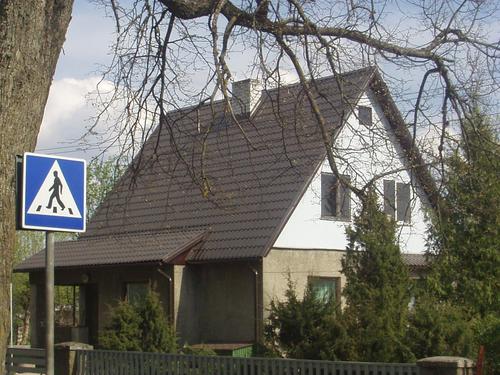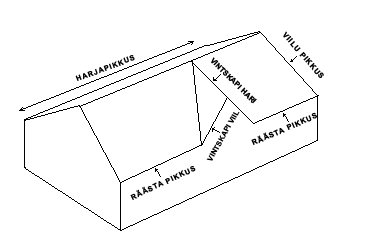 The roofing cladding together with exterior walls and floors are a cover of the building, whose task is to provide protection to the interior space from outside impact. The latter is more rigid in the northern countries than elsewhere in the world, the atmospheric temperature fluctuating between -30oC up to +30oC.
The roofing cladding together with exterior walls and floors are a cover of the building, whose task is to provide protection to the interior space from outside impact. The latter is more rigid in the northern countries than elsewhere in the world, the atmospheric temperature fluctuating between -30oC up to +30oC.
Despite this, the interior temperature should remain stable. The task of the roofing cover is to preserve the entire building safe and dry from precipitation, so as its essential qualities especially keeping of warmth, would comply with the norm.
Impermeability
The roofing cover should be impermeable to all sorts of different conditions. The water gets to he roof in the form of precipitation or brought with the wind blasts during ice storms. In winter, the roofing cover should be protected against the penetration of snow into structures located beneath. Whereas in spring and autumn, it should behave adequately in situations when the cold and thaw alternate.
Depending on the type of roofing cover, the impermeability thereof is achieved in two ways: either the cover itself is made completely waterproof or the underlayer is placed under the roofing cover, which drives the absorbed water or condensed water out from under the roofing cover, either into the rainwater system or just into the eaves. A steel roof that has dense surface is the rolled steel roof. The dense cover does not require underlay. The underlay is recommended for tin profiled and corrugated iron sheets covers. See the installation of underlay in greater detail in the installation manuals.
Weather proof
The natural forces alongside UV rays, temperature, rain, snow, wind are hard burden for the roofing coating (especially difficult is the co-effect of rain and wind). The roofing coating should be resistant to the load. Which is why the materials used and the installation work performed, are faced with very high demands. The roof’s being weather-proof is achieved through the use of correctly chosen materials and well-considered structures.
Resistance
The roof’s coating should be resistant to the blows of branches and other objects tossed by the wind (mechanical factors). Also the repeated drumming of precipitation creates a strong dynamic load. The roofing coat should be resistant to the maintenance work performed on the roof. To facilitate the movement on the roof and to protect the roofing coat, the roofs often ladders and bridges are mounted on the roof. The ever growing air pollution and chemical burden related to that are increasing. The corrosion caused by them affects the roof coating material in a variety of ways. To increase the chemical resistance, more and more improved methods of processing of raw material are applied.
Maintenance
The roof wears out and grows old just like all the other parts of building. Despite the use of materials increasingly more durable, it is not yet appropriate to talk about ?maintenance-free? roof. It is more practical and reasonable to plan regular maintenance activities of the roof to prolong significantly the period of service of the roof. Nonetheless important are practical instructions for removing small defects of the roof.
Appearance
The appearance of the roof depends on the form of the roof, its slope or pitch, material, colours, etc. It has a very important role in creating the overall impression of the building’s appearance, and being a part of the entire building and living environment should comply with certain strict rules. The issues related to the roofs are mainly resolved alongside with building facade solutions.
Choice of roof coating
The roof coating is chosen on the basis of peculiarities of the roof, its slopes, form, etc. This choice affects the possibilities of making the most complicated structures of the roof water-proof. These include, besides joints between sheets, also eaves, inlets, encirclements of ridge and stacks. Not less important is mutual compatibility of rainwater and safety systems with the roof coating. It is important to consider also the peculiarities of installation: some roofs demand a lot of work while others are easily mountable. The most suitable correlation of material and installation price should be established.
How to order a steel roof?
1.First of all you should find out what type of profile is most suitable for a particular type of roof and which you like most. The basic types of profiles are corrugated sheets, tiled profiles and rolled steel profile. For dimensions and drawings of specific profiles see our catalogue of products.
2.Choice of surface coating material. Possibilities: zinc, polyester, matt polyester, pur or PVC. The coating affects the price.
3.Choice of suitable colour. On the basis of these data and precise pre-installation measurements of the roof, the profile and the need of accessories are calculated. The roofing sheets are cut with precise length. The bevel edge is not definitively cut as in the course of possible measurement errors it may later prove useless. Those cuts are made during installation on the site. Do not use abrasive cutting tools!
To make the volume calculations in case of an uncomplicated roof we need the following dimensions:

For complicated roofs, it is useful, having the available dimensions, to draw all the facets of the roofs separately. If it is easily done, you indeed have all the necessary dimensions.
For compiling the price offer, it is enough to submit the design of the building (first and foremost the plan of the roof and the views of the building are important). If an order is made, additional measurements on the site are needed, as dimensions on the drawing often have inaccuracies.
The dimensions are to be submitted by fax, post or in any other way to AS Toode, and do not forget to add your contact data! When transmitting by fax, please avoid using thin and coloured lines, as these will be hardly distinguishable in the fax.
